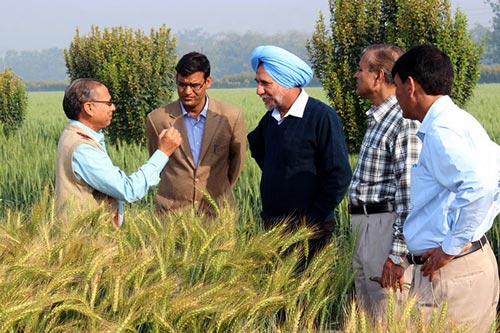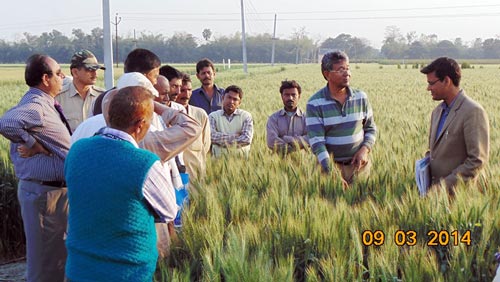By Raj Gupta and Raj Kumar Jat/CIMMYT

A three-day agricultural festival held in India allowed farmers to articulate their production technology needs in the presence of policymakers, researchers and extensionists. The Rajendra Agricultural University (RAU) organized FarmFest from 8-11 March in Pusa, India, and a field day in Mathlupur. The theme of the FarmFest was “Making Agriculture Profitable under Changing Scenarios.”
FarmFest interactive sessions were attended by Gurubachan Singh, chairman, Agricultural Scientists’ Recruitment Board (ASRB); Mangla Rai, agriculture advisor to the chief minister, Government of Bihar; J.S. Sandhu, agriculture commissioner, Government of India; N.N. Singh, former vice-chancellor, Birsa Agriculture University, Ranchi; M.C. Diwaker, director, Directorate of Rice Development, Ministry of Agriculture, Government of India; R.K. Mittal, vice chancellor, RAU; Gopalji Trivedi, former horticulture commissioner, RAU; and H.P. Singh former vice chancellor, RAU.
Raj Gupta, team leader for the Borlaug Institute for South Asia (BISA) Research Station Development and Raj Kumar Jat, cropping systems agronomist, gave a tour of the conservation agriculture hub and briefed the visitors about agricultural research for development activities at BISA, Pusa. Participants collected information on innovative soil-water-crop management practices being developed for smallholder and resourcepoor farmers. Interactions between policymakers and farmers on the BISA farm helped the officials understand the farmers’ needs and how to make agriculture profitable under changing socioeconomic and climatic scenarios and the competing end-use of natural resources.

Discussions focused on the contributions Bihar farmers can make to sustainable ecosystem intensification by shifting from conventional agriculture to conservation agriculture, replacing low-value crops with high-value commodities and further intensifying existing cropping systems practiced in irrigated and rainfed upland and lowland ecologies with appropriate crop cultivar choices. Sandhu’s speech focused on crop diversification and conservation agriculture, especially the permanent raised bed system of crop planting. He also asked the farmers to plant long-duration, water-logging tolerant pigeon pea and to develop intercropping systems. He told farmers to visit the BISA farm and take advantage of the innovative crop production technologies evolving there.
Gubachan Singh was concerned about declining farm holding size and factor productivity. He asked scientists to reorient their research to focus on the needs of smallholder farmers. Rai reminded farmers of the power of cooperative efforts in procuring farm inputs and marketing their produce. Without policy corrections such as buying in retail and selling in bulk, it is difficult to make agriculture profitable, but collective efforts can help.
 Capacity development
Capacity development 
